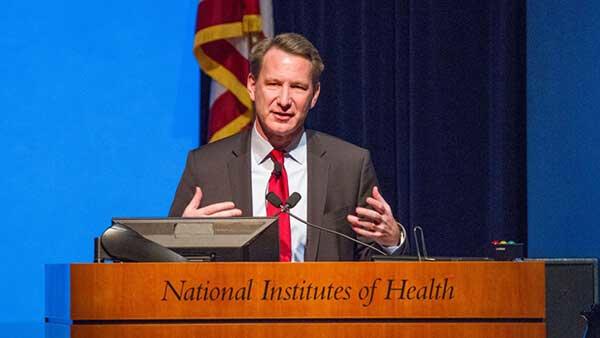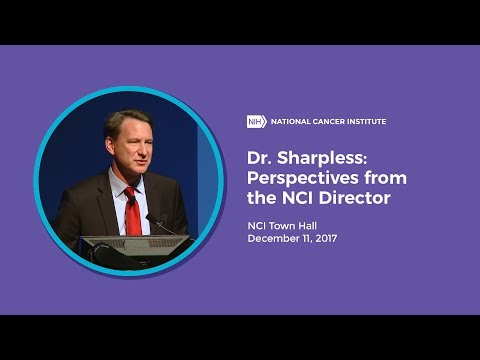NCI: Taking Risks to Advance Science
, by Norman E. Sharpless, M.D.
I’ve officially been at NIH as the NCI director for 2 months. That time has flown by.
I say, “as the NCI director” because most people don’t know that this is my second stint at NIH. My first job working in a laboratory, in 1990, was in Bethesda, as part of an NIH-Howard Hughes Medical Institute program.
I still remember attending seminars on cancer by Michael Gottesman, Carl Wu, and John Minna. I was thrilled to be living on campus and relished working with the other scholars, all of whom were so bright and dynamic. I absolutely loved the intellectually stimulating milieu of NIH. And I recall telling people within a month of starting at NIH that this already felt like the best year of my life.
Since that time, my research career has been closely connected to and largely supported by NCI and NIH—as a fellow and grantee, and during service on study sections and advisory boards. So, for a long time, I’ve known just how special NCI is. And in many ways, it feels like I have returned home.
In the months since I was named director, I have used the time to meet and speak with many at NCI and in the cancer community—including every living former NCI director—about their work and passions. I’ve truly been on a “listening and learning tour,” and it’s been very informative.
I believe that such outreach should be an important component of my role as NCI director—not just initially, but throughout my tenure. That’s why I look forward to talking with many more staff, grantees, and stakeholders about your priorities and challenges, and how NCI can support you to do the best science.
I also had the opportunity last week to speak directly to all NCI staff during a town hall meeting. As I told them, I’m not prepared yet to provide specific thoughts on my plans and priorities for NCI.
That said, I highlighted a few broad areas where I believe NCI has a role to play in advancing progress. NCI’s unique breadth and scope means we have been able to—and should continue to—undertake high-risk research that no other organization can, including studies like NCI-MATCH; large-scale projects like the RAS Initiative and the Cancer MoonshotSM; and innovative partnerships like PACT and the NCI Formulary. I plan to address many of these areas over the coming months as my vision for NCI crystallizes.
My favorite part of the town hall was addressing questions from NCI staff. One question, in particular, has stuck in my mind: How will NCI deliver on the promise of big data?
Let me say up front that I am passionate about how we will use big data to understand, prevent, and treat cancer. Currently, we are very good at describing the stage, pathology, and specific molecular features of a cancer. Yet, we still aren’t sufficiently adept at telling patients what they really want to know: what treatment will work given the underlying biology of their tumor. And that is very frustrating to both patients and clinicians.
A big problem is that we don’t have aggregated data on patients’ response to their treatments. That key clinical information, along with other important patient-specific data, is often buried in unstructured text in doctors’ handwritten notes and in electronic health records.
NCI can play a much-needed leadership role in helping us get from where we are today with big data to where we need to be. This means ensuring data are gathered in a standardized, harmonized fashion so they can be more easily aggregated, shared, and analyzed. Such efforts would allow us to learn from every patient’s data and make better treatment decisions.
To do all this, we need artificial intelligence tools to abstract the gold mine of clinical notations, high-performance computing, massive amounts of cloud storage, and more people to manage this work. The cost of doing this may be high. But the cost of not doing this is even higher.
Last year, I read a paper about acute myeloid leukemia (AML) that really drove home the significance of aggregating treatment response data. The study showed that for patients with a TP53 gene mutation, which about half of AML patients have, the response to chemotherapy clearly differed depending on the drug used.
I treated patients with AML for 20 years and, at the time, there were two therapies that we used, though deciding which to prescribe was based on somewhat arbitrary factors for most patients. What this study demonstrated, however, was that the molecular genetics of the tumor should drive the choice of therapy. We didn’t know that at the time. But the point is, we could have. It would have been apparent had we aggregated the clinical response data from large numbers of patients with AML whose cancer had been genetically sequenced.
That is the power of data aggregation.
This brings me to the heart of why I made the decision to transition from clinical oncologist to research scientist: As much as I enjoyed my work as a clinician, too often, I didn’t have the information at my disposal to make the most effective treatment choices for individual patients. And too often, I felt helpless, much like my patients did. Had this gold mine of clinical data been more accessible, I am certain I could have made better treatment decisions and provided better outcomes for my patients.
That experience of fighting alongside my patients and feeling helpless was a turning point for me. I knew that what we really need are better ways to prevent and treat cancer. And we can only have these if we have a better understanding of the molecular biology of cancer—which I was determined to pursue in the lab.
Over the past decades, we have certainly made amazing progress against cancer. But there are still significant gaps in our understanding of malignant disease. We have much to learn, and basic science is our path to get there.
The question is: How do we make great science happen? How do we get lightning to strike in just the right spot?
From my experience, the most innovative science comes not from a top-down approach, but from creative thoughts bubbling up in unexpected places. And I believe the way to nurture that process is by creating an atmosphere where bright young scientists are encouraged to investigate unconventional and high-risk ideas, which, occasionally, may lead to the next big breakthrough. That creativity is cultivated in an environment of stable funding and access to top-notch infrastructure, limited bureaucracy, and freedom to pursue the most promising ideas.
I have seen how passionately and tirelessly the cancer community works, driven by your commitment to advancing our understanding of cancer and helping our patients live longer, healthier lives.
I can’t think of a better way to continue to contribute to this shared goal than by leading NCI and collaborating with talented investigators, committed advocates, supportive policy makers, forward-thinking industry partners, and many more to advance cancer research.
Thank you for your dedication and caring, and thank you for the warm welcome you’ve given me in these last couple of months.

